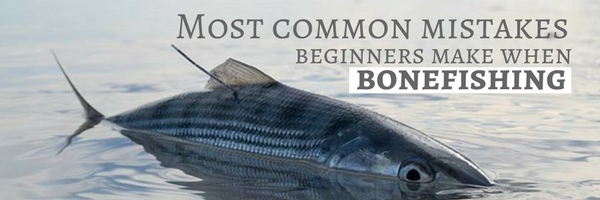Even the most experienced fly fisherman are guaranteed to experience frustration during their first few bonefishing trips.
Before heading out to the flats, you have to prepare for the wind, the glaring sun, and fish that are just as stealthy as they are smart. As ever, people who make the fewest mistakes when bonefishing tend to land the most fish. Following are four, common mistakes that beginners often make along with a few, easy strategies for avoiding them.
1. Too Many False Casts
Practice casting well ahead of your bonefishing trip to make the most of your time out on the flats. Be sure to spend plenty of time casting both into and out of the wind, and in different conditions. Bonefish are often caught within the 40-foot range, but casting has to be done quickly, accurately, and usually under intense pressure. For best results, do more than simply work on your casting distance. Practice casting at 40 feet until you’re able to hit a hula hoop-sized target on a consistent basis, and in all types of wind conditions. You also want to hone your ability to change casting directions with an equal amount of accuracy, and with very few false casts. Bonefish spook easily and every false cast you make will limit your likelihood of hauling one in.
2. Trout Setting
For every trout angler who’s gone bonefishing, the strike has proven to be a major stumbling-block. It’s never a good idea to strike saltwater fish with the rod tip, especially bonefish. When you raise your rod tip, the fly will inevitably lift out of the water. Instead, you want to make a long, firm strip with your line while holding your rod low. One easy way to avoid trout setting is to hold your rod tip several inches below the water’s surface during the retrieve motion so that you maintain excellent control over the line. This is actually the perfect strategy for avoiding a trout strike when it’s already become second nature.
3. Not Staying Hydrated
Time spent on the flats can really take it out of you. You’ll be working hard in high heat, and your body will be fast-using its water stores to protect your skin, hydrate your lungs, and keep you focused. This means that you should be drinking plenty of water both during and after your time on the boat. Make sure to drink several liters of water each day to keep your energy up, your head clear, and all of your internal systems functioning like they should.
4. No Protection
Never underestimate just how quickly the water’s glare can accelerate a sunburn. You certainly don’t want to spend your entire trip dealing with red-hot, achy skin. To keep yourself protected, try covering as much skin as possible. Also, be sure to thoroughly apply sunblock on all exposed areas. Find out how long your sunblock lasts and always stash a small supply in your gear so that you can reapply as needed. You’ll also need a pair of polarized sunglasses and a decent sun hat.









